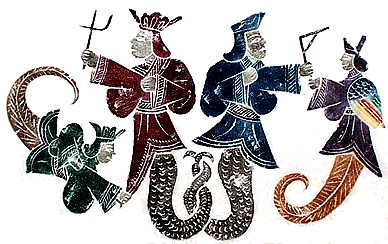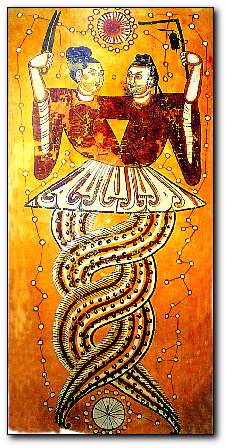Two Types of Movement: Predator and Unstoppable
/There are lots of different ways of moving. What I'm provisionally calling "pure internal movement" is predicated on making clear distinctions between different types of movement. Without those distinctions there is no way to define either "pure" or "internal."
Here are two distinct types of movement which have the potential to profoundly improve the way people move.
1) Predator movement is always "on" your opponent. I mean really on them, before, during, and after contact. Make them double-weighted, make them carry you. Make your mind like a dark cloud surrounding your opponent's body, shooting lightning bolts into his openings. As a predator, your opponent should smell like food, or like that first cup of coffee in the morning. And also imagine you are leaving your scent all over your opponent. Needless to say, predator movement uses all the senses.
Predator movement can not be pre-set, it must be improvised. It must be immediately and continuously responsive. Predator movement can be used to control, but it is leading and initiating the action, not resisting it. In other words, using predator movement, I can move someone around in space, where ever I want them to go, but the patterns I make in space cannot be pre-set in anyway.
2) Unstoppable movement is "on" me. It uses pre-set movement patterns with resistance. When performing unstoppable movement, I do not modify the external appearance of my form or routine. Resistance must be offered by a partner, that resistance cannot be pre-set, in must be spontaneous.
When performing unstoppable movement, I can be doing a form, but if my partner disconnects I will not follow him. My partner is responsible for providing spontaneous resistance against the set patterns of my movement. In this situation my partner could just disconnect and then poke me in the eye. It isn't a fighting mode. It is a way to purify the quality of one's movement. It is a testing ground.
With unstoppable movement, my movement pattern is visibly predictable, my partner's is not. I don't control my partner's body in space. I am spontaneously adapting to whatever resistance she offers. That is why it is "pure" internal; on the outside I am just doing a form, but on the inside I am creative and dynamic.
With unstoppable movement I can not move my partner wherever I want. I can only follow my own pre-set pattern.
__________________________________________
Both of these types of movement are key. Unfortunately, many martial artists attempt to do both types of movement at the same time. This causes both to fail.
There are actually three possibilities, 1) follow and evade, 2) follow and evade while offering resistance, 3) lead by improvising.*
Fixed patterns of movement don't produce set responses. There is no positive value in training them that way.
There are ways of moving, two-person forms, for instance, in which both people are doing, linked, pre-set movement. I like this type of practice, but it is important to understand why it fails. Don't try to do both predator and unstoppable movement at the same time--that will produce negative results; instead, change between the different types of movement, or practice in one of the two "pure" modes.
__________________________________________
Spontaneously communicating ideas, like talking to a friend in a cafe, is like predator movement, it is the perfection of mind/shen. When we communicate spontaneously we can adjust, repeat, reframe etc...as needed.
Writing a book, is like unstoppable movement, it is the the perfection of form/jing. The reader offers criticism, resistance, analysis, questions, and responses. If the book is well written, all this thoughtful engagement makes the book more effective...but the words are pre-set.
_________________________________________
*Footnote from above, for my friends in the theater [In the Keith Johnstone's improvisational theater 1) is called "accept all offers", 2) is called "accept and block," 3) is called "making blind offers."]

 I’ve been working with the “ball” material I wrote about in the last post and I’ve decided that there is an other way to explain it.
I’ve been working with the “ball” material I wrote about in the last post and I’ve decided that there is an other way to explain it. I used the term autonomic above. The nervous system is divided into two types of nerves, the ones that control obviously voluntary actions (yes that would include ear wiggling even if you aren’t very good at it yet); and nerves that control much less voluntary things like pupil size and heart rate. The less voluntary system is called the autonomic nervous system and it is also divided into two parts. One part that is active when you take a deep relaxing breath while sitting in a hot tub, and another part that is active when you hold your breath, tense up your muscles, pull back your lips and grit your teeth. The relaxing nervous system is called para-sympathetic, the stressed out nervous system is called sympathetic. (I know the names are ridiculous, they refer to anatomy you only see when you are doing a dissections.)
I used the term autonomic above. The nervous system is divided into two types of nerves, the ones that control obviously voluntary actions (yes that would include ear wiggling even if you aren’t very good at it yet); and nerves that control much less voluntary things like pupil size and heart rate. The less voluntary system is called the autonomic nervous system and it is also divided into two parts. One part that is active when you take a deep relaxing breath while sitting in a hot tub, and another part that is active when you hold your breath, tense up your muscles, pull back your lips and grit your teeth. The relaxing nervous system is called para-sympathetic, the stressed out nervous system is called sympathetic. (I know the names are ridiculous, they refer to anatomy you only see when you are doing a dissections.)